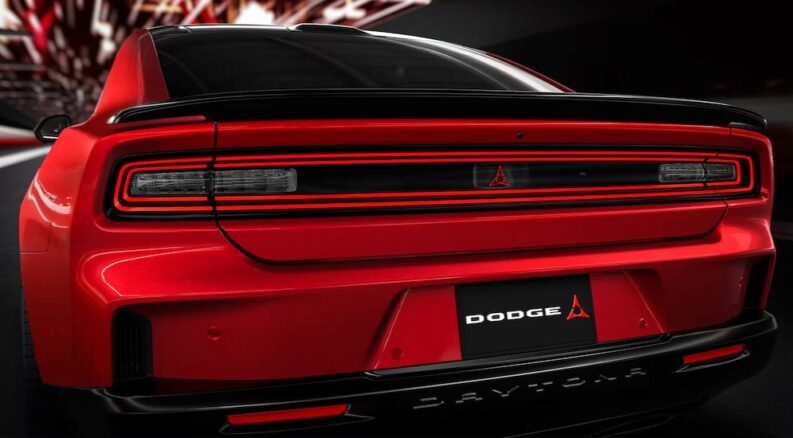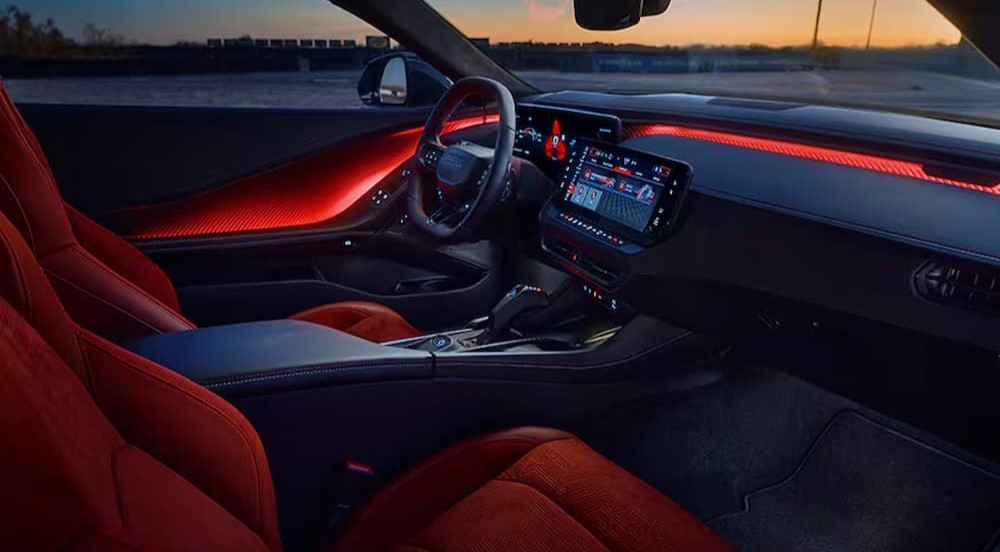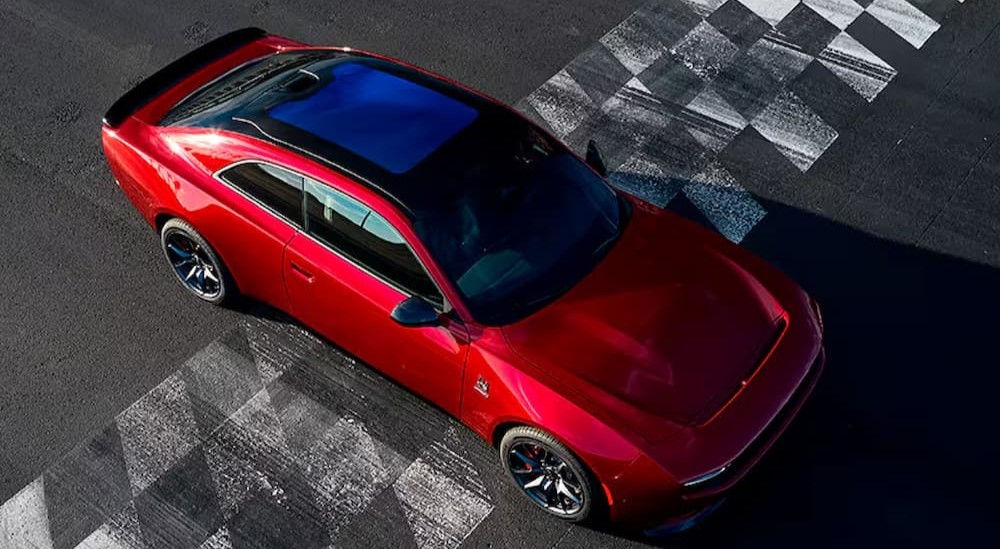There’s no denying the Dodge Charger’s impact on the auto industry over the last 50-plus years, but is the new all-electric Daytona model really the world’s most powerful muscle car? That’s Dodge’s claim, though the truth might be slightly more complicated. While the EV version of the classic muscle car boasts up to 670 hp when opting for the range-topping Daytona Scat Pack trim, the Charger Daytona faces some stiff competition from a strong field of battery-powered newcomers. Tesla and Lucid are bringing their EV expertise to the performance segment with cars like the Model S Plaid and Air Sapphire, while Porsche builds on its reputation for rapidity with the Taycan Turbo GT. All three models exceed the vaunted 1,000-horsepower mark, a figure that would seemingly invalidate the Daytona’s “most powerful muscle car,” but the Charger might just squeak by on a technicality. Read on as we get to the bottom of Dodge’s lofty assertion and see if the Charger Daytona really has what it takes to claim the muscle car crown.
Performance
The Charger Daytona doesn’t just do the Charger name proud with its 670-horsepower setup. It blows the doors off its predecessor by a good 100 ponies. Meanwhile, the 2025 Charger Sixpack is driven by a twin-turbocharged inline-six Hurricane engine that can make 420 hp in the Sixpack Standard Output model and up to 550 hp in the Sixpack High Output trim. Those are some impressive numbers, but the Daytona’s 400-volt electric architecture and EV powertrain allow Dodge to unlock a new level of performance. The electrified muscle car’s dual-motor design gives the Daytona standard AWD while allowing each axle to churn out 335 hp and 314 lb-ft of torque. In order to maximize the Charger’s performance potential, Dodge has included its Direct Connection Stage power upgrade kits as a standard feature. The kits provide a brief 15-second power boost that gives the Daytona R/T an extra 40 hp, while the Daytona Scat Pack earns 80 additional ponies to reach the 670 mark.
Porsche’s Porsche Taycan EV starts off with a (relatively) modest 402-hp setup on the base trim, but that number quickly balloons to 536 for the 4S, 690 for the GTS, and up to 938 for the Turbo S when enabling the Launch Control feature. Still, that’s no match for the Taycan Turbo GT. New for 2025, the Turbo GT sports a dual-motor setup that gives it 777 hp, or up to 1,019 hp and 988 lb-ft of torque when enabling Launch Control. The Model S Plaid edges out the Taycan Turbo GT by the slightest of margins with a tri-motor design that lets the Tesla pump out 1,020 hp and 1,050 lb-ft of torque while providing drivers with full-time AWD. Then there’s the Lucid Air Sapphire. Packing 1,234 hp and 1,430 lb-ft of torque, the Sapphire isn’t just fast, it’s historically fast. The luxury sedan is the quickest production EV ever tested and has the MSRP to match. Ringing in at a cool $250,000, the Lucid Air Sapphire is a bonafide supercar when it comes to both price and performance. Those seeking a more affordable alternative can always invest in the bargain-priced Pure trim for around $70,000 but should be aware that the base model features just a third of the power of Lucid’s crown jewel.
Zero to 60 MPH
Pure horsepower and torque can be handy stats when it comes to comparing models, but these two figures often lack some crucial context. If you really want to know how a car is going to perform when the rubber hits the road, acceleration can be a very useful metric. The Charger Daytona is pretty quick off the line, offering drivers a 3.3-second zero-to-60 mph time identical to the internal combustion version in its Sixpack H.O. trim. The Charger Daytona is even speedier than Dodge’s other muscle car, the smaller Challenger, which clocks in at 3.6 seconds for the Hellcat Redeye model. If there’s one area where the EV is sorely lacking, it would have to be the top speed. The Charger Daytona can climb to 135 mph, which, while respectable, pales compared to some of the other EVs in the running.
The Model S Plaid can sprint to 60 mph in as little as 2.1 seconds and offers a top speed of 163 mph, providing the sort of acceleration that, not so long ago, was limited to a select cadre of high-performance supercars. The Porsche Taycan Turbo GT shaves 0.2 seconds off the Tesla’s time for a total of 1.9 seconds, though that number might be a bit lower if you opt for all the available performance-related upgrades like the optional Weissach package with its fixed rear wing, front and rear splitters, underbody enhancements, and lightweight components designed to improve the EV’s handling and downforce. The Taycan’s speedometer tops out at 180 to 190 mph, which sounds pretty stellar until you look at the Lucid Air Sapphire. The quarter-million-dollar EV justifies its high price tag with a top speed of 207 mph, which might even be a little higher if not for the built-in governor. Lucid’s contender does deliver the same 1.9-second zero-to-60-mph time as the Taycan Turbo GT, though 2.1 seconds might be a more realistic figure outside of professional race tracks.
What’s in a Muscle Car
The stat sheet looks pretty damning when it comes to the Charger Daytona’s “most powerful” designation, but the numbers don’t always tell the true story. Dodge seems to have picked its words pretty carefully when labeling the Charger EV as the world’s top muscle car, as the category tends to carry strict standards related to design, performance, and provenance. While there are no concrete prerequisites that define the segment, the term is generally used to describe American-made, two-door coupes with boxy, aggressive designs, rear-wheel drive, and brawny V8 engines. We’ll allow a little wiggle room when it comes to the gas-powered V8 as all-electric powertrains have thoroughly proven their ability to meet or exceed their ancestors in terms of performance, and the “American-made” requirement seems a little outdated in today’s globalized economy, but how does the Charger Daytona compare in the other categories?
While the debut 2024 model adhered to the two-door ethos that’s long defined the segment, Dodge did introduce a new sedan model for 2025. The larger four-door Charger may lose a few fractions of a second in terms of pure acceleration, but it also makes the EV a far more practical choice as a daily driver. The Lucid, Tesla, and Porsche are all limited to four-door models, though the latter does remove the backseat (if not the doors) when opting for the Weissach package. The next-generation Charger has lost a bit of its edge when it comes to the traditional boxy design, but it’s still a little squarer than your average high-performance model and all the better for it. It also retains the long-hood and short-rear deck design that gives muscle cars their distinctive shape, while the Lucid, Porsche, and Tesla opt for a more generic, aerodynamic profile.
That said, the strongest argument for the Charger Daytona’s claim might just be its price. While today’s muscle cars tend to fall on the higher end of the cost spectrum, early muscle cars were largely designed with a focus on affordability. General Motors arguably invented the muscle car formula when it dropped the Oldsmobile 98’s 5.0L Rocket V8 engine into the smaller, more affordable Oldsmobile 88. This mix of value and performance turned out to be a winning proposition, allowing younger car enthusiasts to access the sort of power once limited to luxury models. The early muscle cars served as four-wheeled statement pieces, with drivers customizing and upgrading their rides as part of the post-war automotive culture familiar to anyone who’s ever watched Danny Zuko dance atop his 1948 Ford De Luxe.
The Verdict
The Charger Daytona might not be quite as accessible as many of the industry’s early muscle cars, but its $77,000 MSRP is pretty reasonable when compared to the test of the models mentioned in this article. The Model S is a relative bargain at around $91,000, but the Porsche and Lucid will break all but the most well-stocked banks, with the Taycan Turbo GT and Air Sapphire retailing for between $230,000 and $250,000, respectively. While we can’t peg a specific cutoff that can be used to separate muscle cars from all-out supercars, the six-figure mark seems like a reasonable limit. The Dodge Charger Daytona might not have all the heavy-duty equipment needed to keep pace with the Porsche and Tesla, but it’s a far more realistic option for those looking to get a taste of the performance lifestyle without essentially forking over a second mortgage. The EV also features more advanced tech than the muscle cars of old, from custom driving modes that range from Donut, Drift, and Line Lock settings to a Performance Pages app that allows drivers to record relevant driving data like timers, G-forces, and gauges.
Sure, the Charger Daytona can’t touch the Porsche, Lucid, or even the Tesla in the realm of raw performance and would certainly bring up the rear in any straight-on sprint, but muscle cars have never been solely defined but what’s under the hood. 670 hp is still more than enough to get your blood pumping, and if you factor in the EV’s classic design, affordability, and available two-door model, the Charger Daytona is still a heck of a lot of muscle for the money while still remaining a little more practical than some of the higher-priced options. Is it the most powerful car on the road today? Not even close. But if you adhere to the strictest definition of the modern muscle car and aren’t the sort of V8 purist that boycotts any battery-powered model, the 2025 Dodge Charger Daytona has a legitimate claim to the title of the world’s most powerful muscle car.






